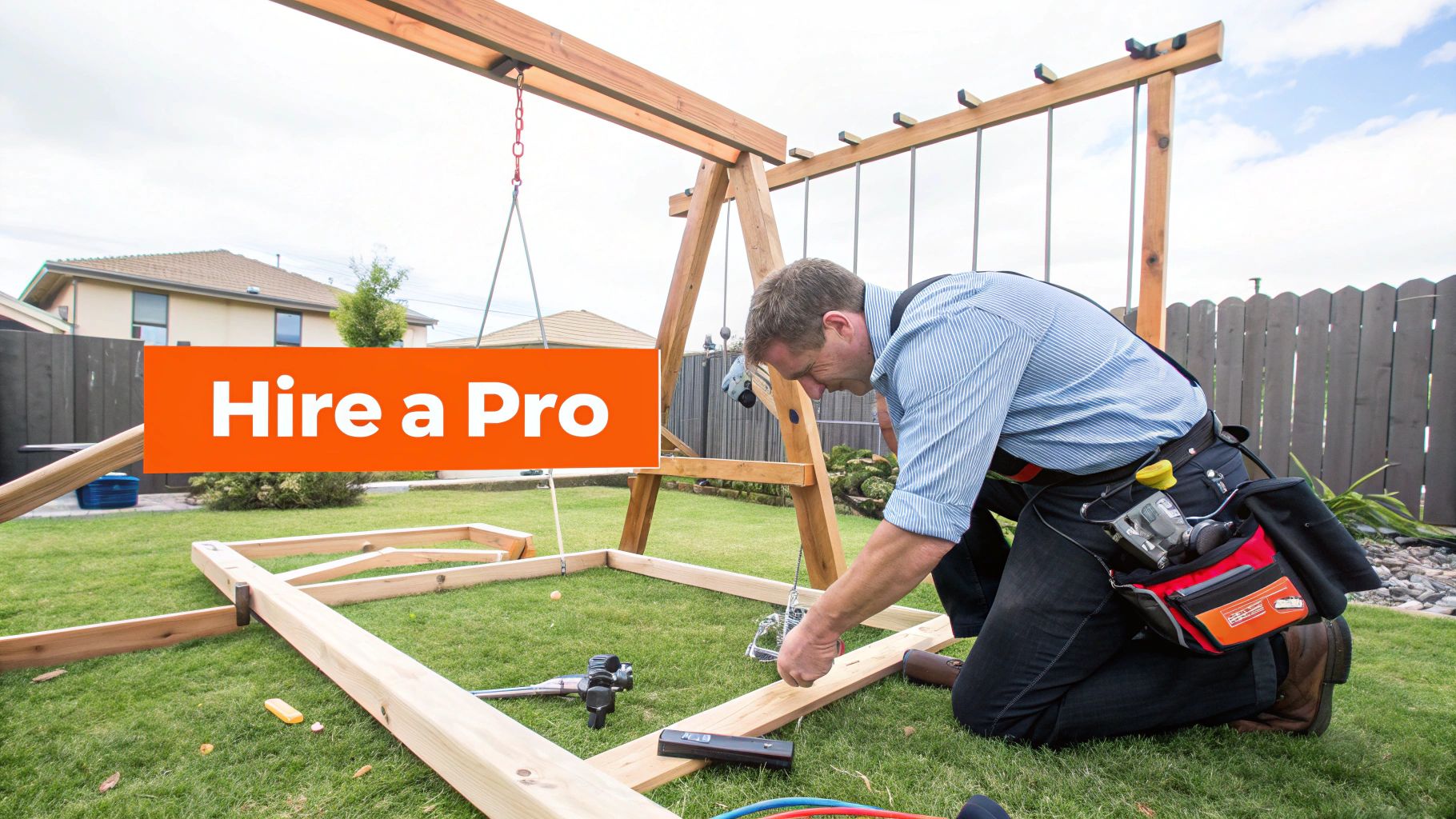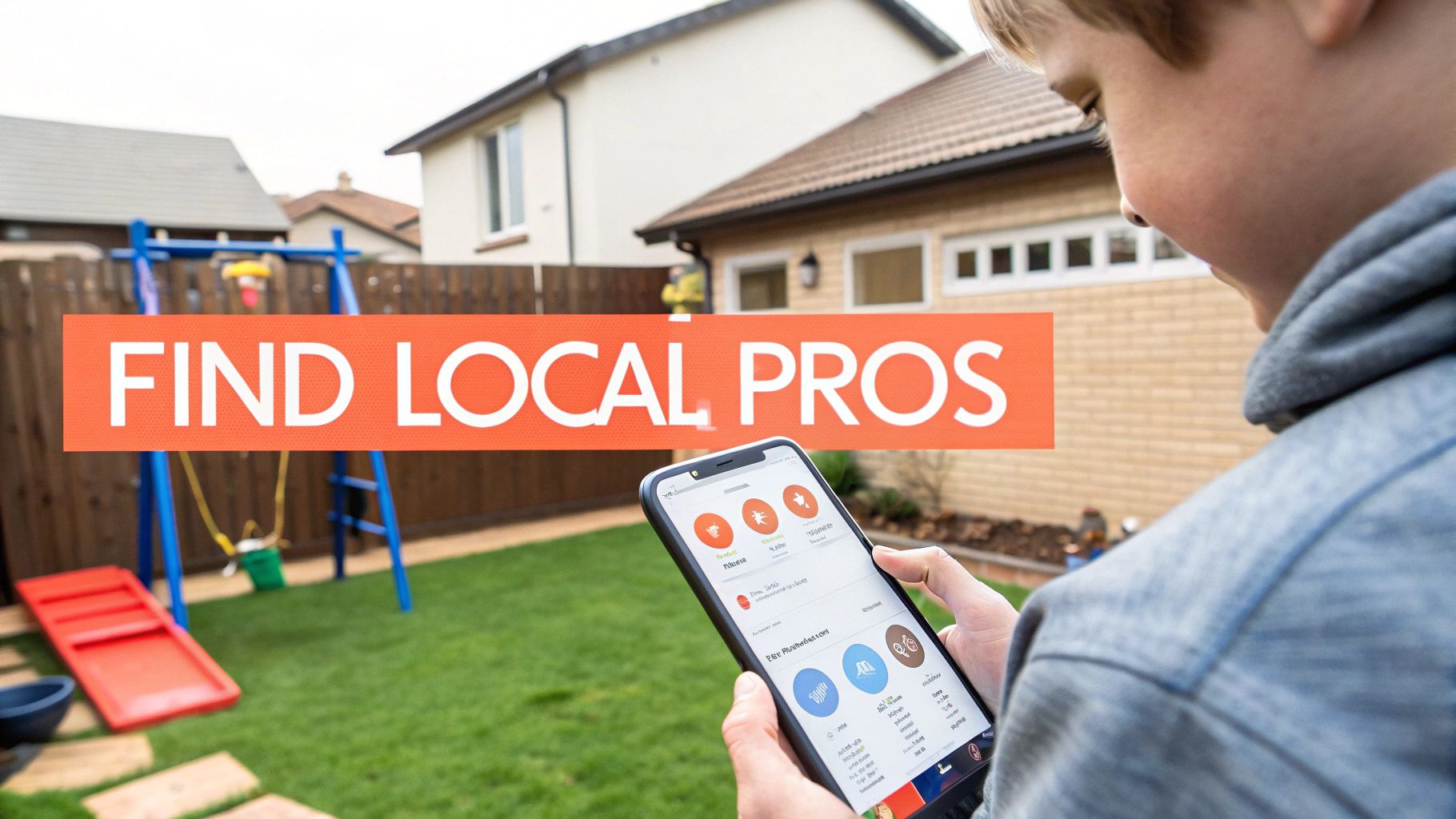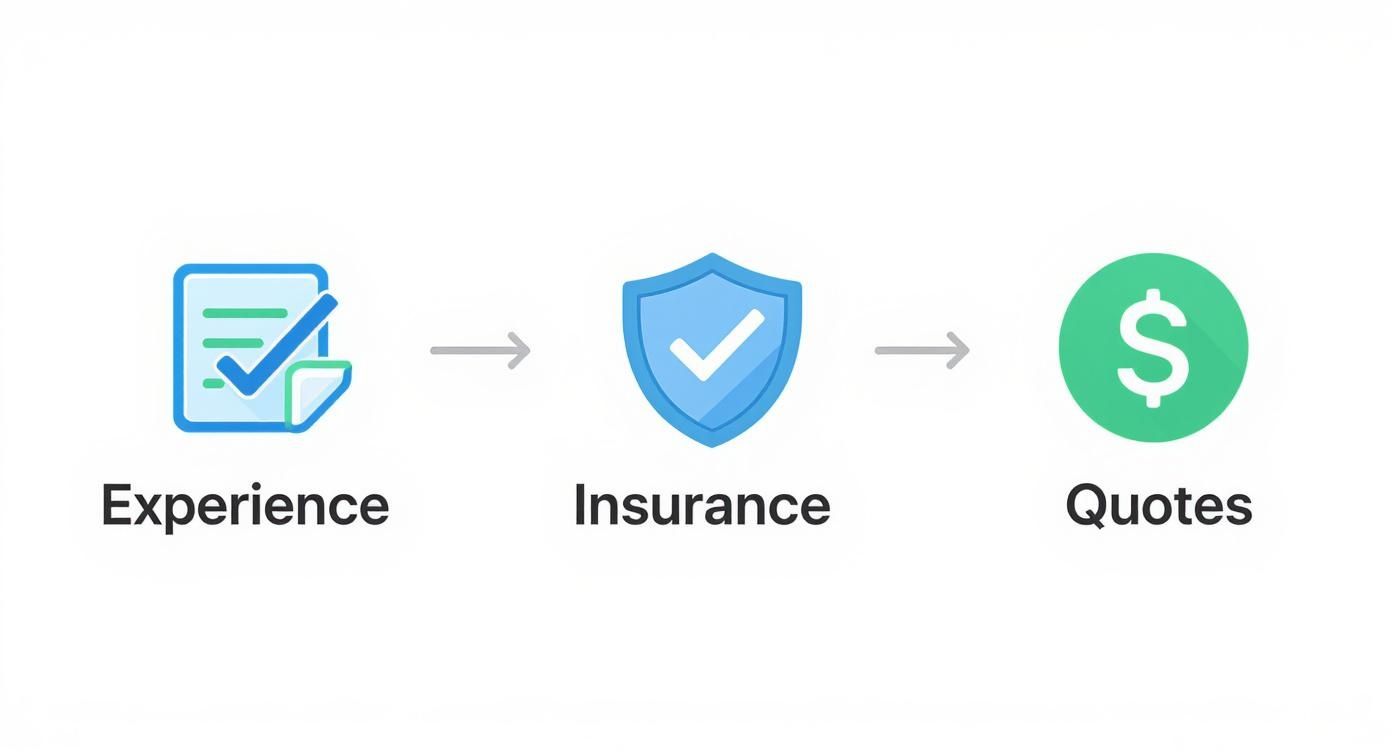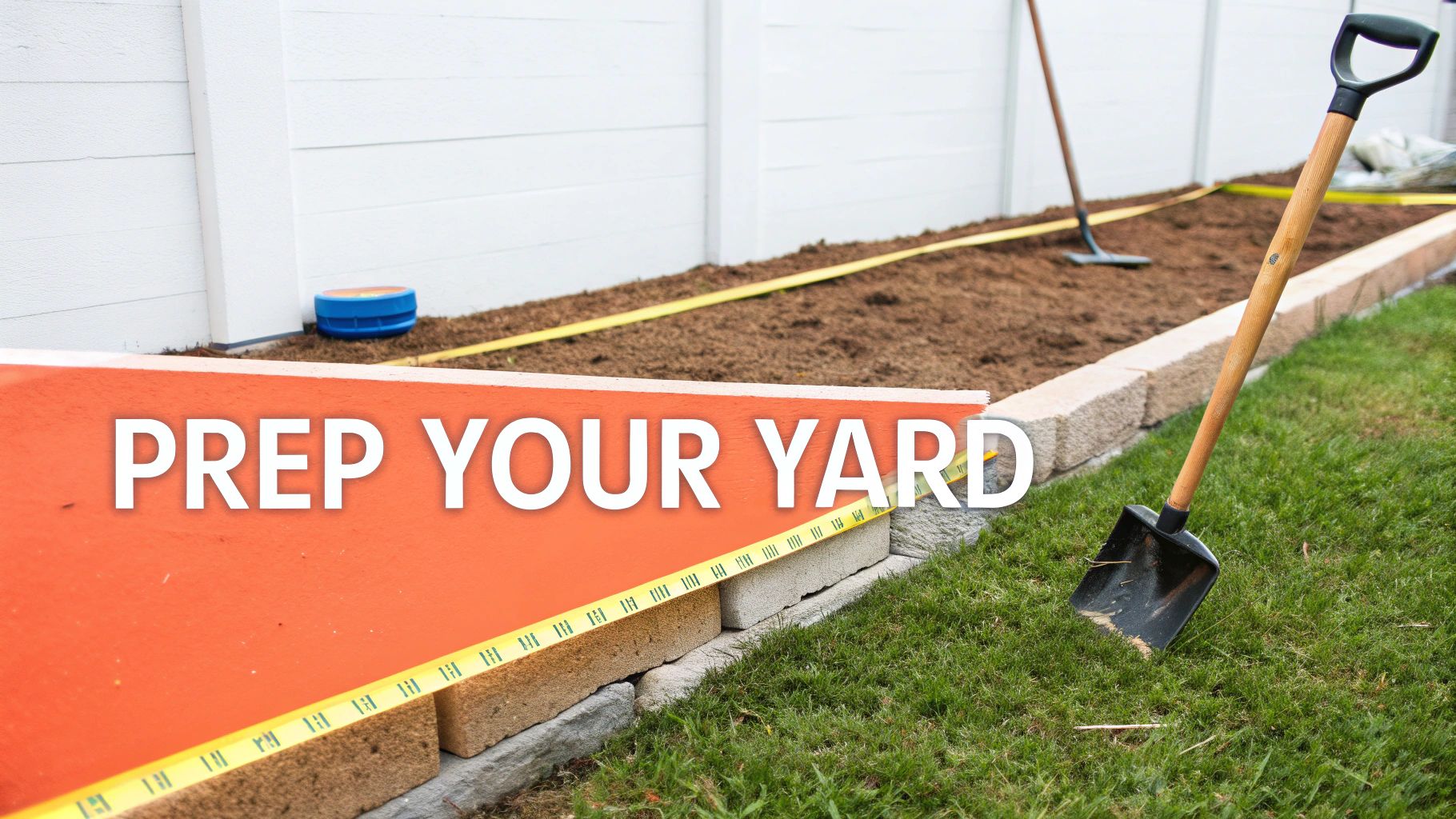-
CALL US:
- (866) 952-3456
That giant box in your garage holds the promise of countless hours of backyard fun, but let's be honest—the thought of assembling it is probably a little intimidating. If you're staring at a mountain of parts and a phonebook-sized instruction manual, hiring a professional for swing set installation services near me is the fastest path to a safe, sturdy playground and your own peace of mind.
This guide will walk you through exactly why leaving it to an expert is one of the smartest investments you can make for your family.

Choosing a professional to build your swing set isn't just about saving yourself a headache. It's a strategic move that pays off in safety, durability, and getting your weekend back. A DIY project that seems straightforward on paper can quickly eat up 10-15 hours, leading to serious frustration and, even worse, critical assembly mistakes.
An experienced installer has put together dozens, if not hundreds, of these playsets. They spot potential problems long before they happen, from making sense of confusing diagrams to ensuring every single bolt is tightened perfectly. That's a level of expertise you just can't get from reading the manual.
When you hire a pro, you’re getting a lot more than just an extra set of hands. You're investing in:
Let's quickly compare the two approaches.
Deciding between hiring a professional and tackling the assembly yourself comes down to weighing time, safety, and cost. Here’s a quick breakdown to help you see the bigger picture.
| Factor | Professional Installation | DIY Installation |
|---|---|---|
| Safety | Built to manufacturer specs by an expert, ensuring structural integrity and proper anchoring. | High risk of errors like loose bolts or unlevel setup, which can compromise safety. |
| Time | Typically completed in 3-6 hours, freeing up your weekend. | Can easily take 10-15+ hours over multiple days, depending on complexity. |
| Tools | The installer arrives with all necessary specialized tools. | May require you to buy or rent specific tools you don't own. |
| Warranty | Professional assembly often protects the manufacturer's warranty. | Improper DIY assembly can void the warranty, leaving you to pay for replacement parts. |
| Cost | Upfront cost for labor, but prevents costly mistakes. | "Free" labor, but mistakes can lead to expensive repairs or part replacements. |
Ultimately, while the DIY route seems cheaper initially, the expertise and efficiency of a professional installer provide invaluable peace of mind.
The cost is also more straightforward than you might think. While you pay for the service, that upfront cost often prevents bigger, more expensive mistakes down the road. The average cost for professional swing set installation in the U.S. is around $515, with most people paying somewhere between $332 and $713. You can discover more insights about the growing demand for quality outdoor play equipment.
A correctly assembled swing set not only guarantees a safer play environment but also protects your investment. Improper installation can void manufacturer warranties, leaving you responsible for the cost of replacement parts.

Alright, you've decided to bring in a pro. Smart move. Now comes the real task: finding the right one. A quick search for "swing set installation services near me" will give you plenty of results, but the trick is knowing where to look and how to cut through the noise.
You're not just looking for a general handyman. The goal here is to find someone with specific, proven experience putting together playground equipment. It's a different beast than assembling a bookshelf.
These days, websites and apps like Thumbtack, Angi, and TaskRabbit are often the first stop. They're a fast way to get in touch with local installers and see their qualifications all in one spot.
When you post your project, get specific. Don't just say "assembly." Use phrases like "swing set assembly," "playground installation," or "playset construction." This detail is your first filter, helping attract bids from people who actually specialize in this kind of work.
As you browse their profiles, keep a sharp eye out for a few key things:
While these platforms are a fantastic starting point, they aren't the only game in town. Sometimes the real experts operate on their own.
Think beyond the general task apps and search for companies that live and breathe playground equipment. These businesses handle everything from backyard swing sets to full-blown commercial park installations.
A search for dedicated playground equipment installers will usually connect you with specialists who have deep industry knowledge. They’re the ones who really understand the quirks of different brands and are better equipped to handle those big, complex, or custom sets.
A personal recommendation is often the most reliable lead you can get. A neighbor who recently had a positive experience can provide honest feedback on an installer's professionalism, timeliness, and quality of work.
Don't forget about the local resources that might not show up on the first page of Google. Tapping into your own community can unearth some highly skilled and trusted installers who get most of their business from word-of-mouth.
Give these local avenues a try:
Okay, so you've got a shortlist of potential installers. Now for the real work. Finding someone who can just slap a swing set together is easy, but you're looking for a true professional who puts safety and quality first. Honestly, taking the time to properly vet your candidates is the single most important thing you can do to get a secure, long-lasting playset for your family.
This isn't just about a quick phone call. You need to ask some pointed questions, see their credentials, and really break down what each installer is offering. Think of it as an interview for a critical job—because that's exactly what it is.
Before you even get to the price, you need to feel confident in their expertise and professionalism. An experienced installer will have zero issues answering these questions. If you get hesitation or vague answers, consider that a major red flag.
Kick things off with these essentials:
For a more exhaustive list of what to cover, take a look at our complete contractor hiring checklist. It gives you a great framework for vetting any professional you hire for projects around the house.
Online reviews can give you some great clues, but you have to learn to read between the lines. Don't just glance at the star rating; look for patterns in the actual comments. Consistent praise for professionalism, showing up on time, and attention to safety is a fantastic sign. On the other hand, if you see repeated complaints about surprise fees or leaving a mess behind, that should give you pause.

This visual really nails the three pillars you should focus on: a proven track record, proper insurance, and transparent pricing.
Your goal should be to get at least three detailed, written quotes. A quote over the phone is just a starting point, but a written estimate locks in the details and helps prevent any nasty surprises later.
When you're comparing these quotes, don't just jump to the final number at the bottom. A quality quote will break everything down for you. The average cost for professional swing set installation can be anywhere from $150 to $1,500, but most people end up paying somewhere around $515 for a standard setup. With labor often running between $50 and $100 per hour, you need to be sure the quote specifies exactly what's included in that rate.
Make sure the estimates clearly state if there are charges for:
Going with the cheapest option isn't always the smart move. You want to hire the installer who gives you the most transparent quote, clearly knows their stuff, and ultimately, gives you the most confidence.

Before your installer even pulls up to the curb, a little bit of prep work in your yard can make all the difference. Taking the time to get the site ready is the secret to a smooth, efficient, and—most importantly—safe installation.
This isn't just about clearing a patch of grass. It's about laying a secure foundation for years of laughter and play.
And it’s clear families are prioritizing this kind of backyard fun more than ever. The children's outdoor swing market was valued at around USD 5.23 billion in 2024 and is expected to hit nearly USD 6.92 billion by 2033. It’s a serious investment in your family’s happiness, and that investment deserves the best possible start.
It all begins with picking the perfect spot.
Hands down, the most critical decision you'll make is where to put the swing set. The ideal location is a nice, flat area where you can easily see it from a window. A slight grade might not seem like a big deal, but for stability and safety, a perfectly level surface is non-negotiable.
You also need to think about the safety perimeter. Plan for at least six feet of clear space on all sides of the playset. This buffer zone is crucial for preventing kids from colliding with a fence, a tree, or the side of the house during a particularly enthusiastic swing.
Pay special attention to the path of the swings and the end of the slide—these high-traffic zones need the most clearance. Once you've got your spot picked out, use some small flags or even just sticks to mark the corners. This simple step eliminates any guesswork for the installer on the big day.
With the location locked in, it's time to get the area completely clear. You’ll want to remove anything that could be a tripping hazard or get in the way of the assembly.
Here’s a quick checklist to run through:
Proper ground prep is also key for anchoring the set, which is a vital safety step. To really understand why, check out our guide on why swing set ground anchors are essential.
What's under the swing set is just as important as the swing set itself. A soft, shock-absorbing surface is your number one defense against injuries from the inevitable tumble. Hard-packed dirt and grass just don't cut it.
A proper safety surface is the single most important feature for preventing serious playground injuries. The U.S. Consumer Product Safety Commission (CPSC) states that falls to the surface are the most common cause of playground-related injuries.
There are a few great options out there, each with its own pros and cons.
Choosing the right material often comes down to budget, aesthetics, and how much maintenance you're willing to do. Here’s a quick comparison to help you decide.
| Material | Average Cost per Sq. Ft. | Pros | Cons |
|---|---|---|---|
| Rubber Mulch | $8 – $16 | Excellent shock absorption, very durable | Higher upfront cost, can get hot in direct sun |
| Engineered Wood Fiber | $3 – $7 | Natural look, good fall protection, affordable | Requires occasional top-offs as it compacts |
| Pea Gravel | $1 – $3 | Inexpensive, good drainage | Can be a choking hazard for small kids, less effective cushioning |
| Sand | $1 – $4 | Very cheap, readily available | Hides debris/animal waste, gets everywhere, compacts when wet |
No matter which surface you go with, the best time to install it is after the swing set has been fully built and anchored. That way, you can spread the material evenly and make sure you have maximum protection right where you need it.
Knowing the game plan for installation day turns what could be a chaotic experience into a smooth, stress-free one. When you hire a professional installer, they don't just show up and start building. They follow a methodical process designed for safety and efficiency, turning that giant pile of boxes into a sturdy backyard centerpiece.
Your job is pretty simple, but it's important. You don’t need to hover over their shoulder for hours, but you should plan to be there for two key moments: right at the beginning and at the very end. This bookending ensures the final product is exactly what you envisioned, right where you want it.
The whole thing kicks off the moment the installers arrive.
First things first, the installers will greet you and do a quick walk-through of the area you’ve prepped. This is your chance to physically point out the exact spot you’ve chosen and confirm how the playset should be oriented. A simple confirmation like, "Yep, we want the slide facing this way, towards the house," prevents any headaches or misunderstandings later.
Once the location is locked in, their next task is a full inventory. They'll systematically unbox and account for every single piece of wood, every bolt, and every bracket, checking it all against the manufacturer’s parts list. This might seem tedious, but this meticulous check is what keeps a project from getting derailed halfway through by a missing part.
With all the parts accounted for, the real work begins. The installers will start assembling the main structure, working from the ground up. With practiced efficiency, you’ll see the frame, A-frames, and main fort start to take shape. They have the right tools and know-how to handle those heavy beams and awkward angles safely.
After the main build, the team will securely attach all the fun accessories—the slides, rock walls, and swing beams. The most critical final step is anchoring the playset to the ground. This is an absolute non-negotiable safety measure that keeps the structure from tipping or shifting during even the most enthusiastic play, and any true professional will insist on it.
Your final walkthrough is the most important part of the process. It's your opportunity to physically inspect the work, ask questions, and ensure every component is secure before you sign off and make the final payment.
When the installers tell you the job is done, it’s time for your inspection. Don't be shy here—this is your moment to make sure you’re 100% satisfied.
Use this simple checklist to guide you:
Once you’ve gone through this list, you can confidently sign off on the project, knowing your new swing set is ready for years of safe and happy play.
Even after you've zeroed in on a few installers, you probably still have some questions floating around. It's totally normal. Putting together a playset can seem like a huge project, but getting a few key details ironed out beforehand makes everything go much smoother.
Let's walk through some of the most common questions we hear from homeowners. Knowing the answers will help you know exactly what to expect.
The honest answer? It really depends on the playset. The timeline can vary quite a bit based on how big and complex the structure is.
A simple, classic A-frame metal swing set is pretty straightforward. A pro can usually get that knocked out and safely secured in just 2 to 4 hours.
But if you've got your heart set on one of those huge wooden fortresses—you know, the ones with a clubhouse, multiple slides, and a rock wall—that's a much bigger job. These elaborate setups can take a professional anywhere from 8 to 16 hours to assemble. That kind of project is often split over two days to make sure every single bolt is perfect.
It's always a smart move to ask your installer for a time estimate before they start. You never know when something unexpected, like a seriously unlevel yard or a part damaged in shipping, might pop up and cause delays.
You definitely don't need to hover over the installer all day, but you'll want to be there for two key moments: the very beginning and the very end.
Being home when the installer first arrives is crucial. This is your chance to point out the exact spot for the swing set and confirm which way it should face. It's a simple step that prevents any "oops, it was supposed to go over there" moments.
Being there at the end is even more important. This is when you'll do the final walkthrough. You get to inspect their work, ask any last-minute questions, and make sure you're 100% happy with the build before you sign off and hand over the final payment.
Finding a cracked beam or a missing bag of bolts when you unbox everything is a real headache. The good news is that any professional installer has seen this before and knows exactly what to do.
Their first move is always to do a full inventory of every piece in the boxes. If they find something is missing or broken, they'll let you know right away.
As the product owner, you'll typically need to be the one to contact the manufacturer and request the replacement parts. Once they arrive, the installer will schedule a time to come back and finish the job. Just keep in mind that some installers may charge a separate trip fee for that second visit, so be sure to ask about their policy.
And if you're taking down an old playset to make room for the new one, looking into local junk removal services can be a lifesaver for clearing out the old stuff.
Yes. 100% yes. Anchoring isn't an optional upgrade—it's a critical safety step that should never, ever be skipped.
Properly anchoring the playset secures it firmly to the ground, which prevents it from tipping, rocking, or shifting while your kids are playing. Tipping accidents are one of the leading causes of serious playground injuries, and anchors are the best defense against them.
Every manufacturer includes specific anchoring instructions, and a reputable installer will follow them to the letter. You can learn more by checking out these essential swing set safety guidelines.
If an installer ever tries to tell you that anchoring isn't needed to save a little time or money, that's a massive red flag. Thank them for their time and find someone else.
Ready to skip the hassle and ensure your new playset is assembled safely and correctly? The expert technicians at Assembly Smart are here to help. We provide fast, reliable, and insured swing set installation services. Get your free, no-obligation quote today!